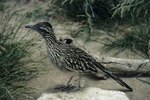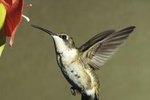
They look and sound like insects. Their wings move from 70-to-80 times per second. The ball-and-socket shoulder joint bone allows their wings to rotate 180 degrees in all directions. They can hover. They are colorful. They look like they have no feet. The Mayans believed these birds were made from the leftovers of other avian species. They are hummingbirds and several varieties can be found in the northeastern United States.
Hummingbird Overview
Hummingbirds are New World birds, found only in North and South America. While listed in the order Apodiformes -- no feet -- the birds actually have very tiny feet. They will perch to rest. Hummingbirds belong to the Trochilidae family, which consists of about 328 species. The birds winter in southern climates and breed in northern locations. While they migrate on the common fly zones, they fly alone so as to avoid predation.
Ruby-Throated Hummingbird
The ruby-throated hummingbird (Archilochus colubris) breeds in the northeastern United States. The U.S. Census bureau defines the northeast as containing nine states: Maine, New Hampshire, Vermont, Rhode Island, Massachusetts, Connecticut, New York, New Jersey and Pennsylvania. Residents can see ruby-throats throughout the summer and during migration seasons. The male sports the bright, ruby-red throat. The female lacks the red-throat and is slightly larger than the male. The baby initially looks like mom.
Rufous Hummingbird
The rufous hummingbird (Selasphorus rufus) traditionally breeds in the western United States, but that's changing. This hummingbird also has been seen in the nine northeastern states. Bob Sargent of the Hummer Bird Study Group calls the rufous the hardiest hummingbird of the species. Habitat destruction might account for the change in breeding sites. Sargent surmises, "a part of the rufous hummingbird population is composed of birds that are no longer ‘tropical’ birds."
Other Vagrants
Vagrants is the term scientists use to describe birds found in unexpected locations. Five other species of hummingbird have been seen in the northeast, including calliope hummingbird (Selasphorus calliope), Allen's hummingbird (Selasphorus sasin), Anna's hummingbird (Calypte anna), black-chinned hummingbird (Archilochus alexandri) and the broad-billed hummingbird (Cynanthus latirostris). These sightings are rare, and as yet, unexplained. The Audubon Society is collecting hummingbird data in an effort to understand the changes in hummingbird migration and breeding grounds.
References
- World of Hummingbirds: Hummingbird Anatomy
- Animal Diversity Web: Trochilidae hummingbirds
- World of Hummingbirds: The History of Hummingbirds
- The World of Hummingbirds: Hummingbird Migration
- US Census Bureau: Census Regions and Divisions of the United States
- Hummingbirds.net: Species Listed by State and Province
- Hummer Bird Study Group: Rufous Hummingbird
- Smithsonian.com: Hummingbirds are Popping Up in the Strangest Places
- Audubon: Hummingbirds at Home
Resources
Photo Credits
-
NA/AbleStock.com/Getty Images



